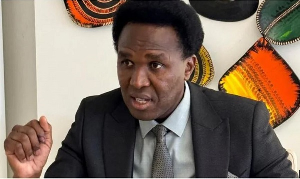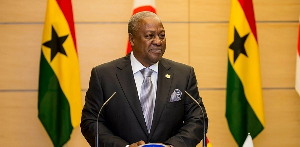The following is the most comprehensive highlights of the Budget Statement presented by the Finance Minister yesterday to Parliament.
Progress made in 2002,
1. Key among these are:
* Domestic revenue mobilization was quite robust on the account of enhanced tax administration;
* In spite of larger-than-anticipated payments relating to wages and salaries, the overall expenditure ceiling was respected, within the Appropriations Act;
* Year on year inflation continued to fall from 21.3 per cent in 2001 to 15.2 per cent at end-2002; and
* The Bank of Ghana strengthened its gross international reserve position from the equivalent of 1.5 months of import cover at end-2001 to 2 months of imports at end-2002
Challenges in 2002
* Higher-than-expected expenditures on wages and salaries;
* Accelerated payments of;
* Higher-than-anticipated subsidies to utility companies;
* Higher expenditures to safeguard security in some sections of the country; and
* Substantial shortfalls in expected foreign inflows.
Macroeconomic Objectives for 2003
2. The key macroeconomic targets for 2003 are the following:
* A real GDP growth rate of at least 4.7 per cent;
* A reduction in the rate of inflation from 15.2 per cent at end 2002 to 9.0 per cent by end 2003;
* An overall budget deficit equivalent to 3.6 per cent of GDP;
* A domestic primary budget surplus of 3.0 per cent of GDP; and the rebuilding of gross official reserve holdings equivalent to 2.3 months of imports of goods and services.
SECTORAL PERFORMANCE IN 2002 AND OUTLOOK FOR 2003
Infrastructure Services Sector
Ministry of Roads and Transport
3. The following projects, among others, have started in earnest:
Tema-Sogakope road; Tetteh Quarshie-Circle interchange road; Nkrumah Circle-Achimota road; Various sections of the Accra-Kumasi road; Bole-Bamboi road; and Bawdie-Asankrangwa road.
4. The Department of Feeder Roads completed 19 bridges which included: Agyei Nkwanta-Chichisa-Manso Amanfi road in the Western Region; Bonsu Nkwanta-Juabeso road in the Western Region; Abodom-Junction road in the Central Region; and Adugyaa Junction – Adugyaa road in the Central Region.
5. Works on the following highways were commissioned for construction by His Excellency, the President: Mallam-Kasoa road; Kasoa-Yamoransa Road; Adenta-Manfe road; Abuakwa-Bibiani road; and Axim Junction-Tarkwa road.
6. Construction and rehabilitation of some major roads in the regions to link rural and urban markets included: Tamale-Yendi road in the Northern Region; Twifo-Praso Assin Fosu road and the Akyem-Achiase-Akenkaasu-Brofoyedru in the Central Region; Agona-Junction-Tarkwa, the Bawdie-Asankragwa and the Sefwi Wiawso-Osei-Kojokrom roads in the Western Region; Jasikan-Brewaniase and the Kpando-Worawora in the Volta Region; Sekyere-Odumase-Nkoranza roads, Sunyani-Ntotroso and Kuntunase-Ejisu roads in the Brong Ahafo and Ashanti Regions; and Kwahu Tafo-Adawso in the Eastern Region.
7. 250 high occupancy mass transport buses are expected in 2003 to augment the fleet. Services will be extended to Kumasi and will eventually cover other parts of the country.
8. The Ministry of Roads and Transport has been allocated a total of ?944.5 billion for its programmes for 2003.
Ministry of Communications and Technology
Performance In 2002
9. Telephone expansion programmes to increase telephone access to the rural communities was extended to the following areas in 2002:-
Hohoe - 5,000 lines
Kpando - 4,000 lines
Kibi - 60 lines
Asiakwa - 30 lines
Dompoase - 30 lines
New Edubiasse - 30 lines
10. The Kofi Annan ICT Centre of Excellence will commence skills development training in 2003.
11. The Ministry of Communication and Technology has been allocated ?62.7 billion for its programmes in 2003
Ministry of Works and Housing
12. In 2002, the Government spent ?18.7 billion to undertake the following projects:
? Construction of 350 hand dug wells, 645 boreholes, 16 mechanized pipe systems, 10 gravity pipe systems, 3,117 household places of convenience and 88 institutional places of convenience.
? Training of 1,300 water and sanitation (WATSAN) committee members, 2,000 hand pump caretakers, 112 partner organizations, 400 Area Mechanics and 100 Artisans to effectively and efficiently manage rural water and sanitation facilities; and
? Rehabilitation of 1,000 boreholes and 500 hand-dug wells countrywide.
13. Government spent approximately US$65.9 million on the Keta Sea Defence Project bringing work completed to date to about 80 per cent.
14. Land reclamation for habitation is now 60 per cent complete.
15. Reclaimed areas for the resettlement of the inhabitants of Kedzi, Vodza
and Adzido are ready for construction works to start.
16. Dredging works are approximately 83 per cent complete.
17. Stage 1 of the Korle Lagoon Ecological Restoration project was completed.
18. Rural water delivery programme for 2003 will be as fellows:
? Construction of 306 new hand dug wells for 25 communities, 1,950 boreholes for 60 communities, 52 mechanized pipe systems for 20 communities and 8 gravity pipe systems;
? Construction of 3,428 household places of convenience, 97 institutional places of convenience and also rehabilitate 82 boreholes countrywide
19. Ghana Water Company Limited will undertake various rehabilitation programmes of water systems at Cape Coast and Winneba, and medium capacity water treatment plants at Sogakope, Keta, Ada Foah and Obuasi.
20. Actual construction work on the US$10.0 million Tamale Storm Water Drainage Project is expected to commence this year.
21. Government will continue to facilitate the construction of 20,000 and 90,000 various housing units for rentals and direct ownership respectively.
22. Government has sourced a Supplier’s Credit of US$120 million for various projects in the housing sub-sector at Berekuso in the Eastern Region, Oyarifa and Manchi-Kuntenase in the Greater Accra Region, known as the “Housing The People Scheme” in the fulfillment of the NPP Manfesto.
The first phase of Project amounting to US$41.35 million will commence this year.
Economic Services Sector
Ministry of Food and Agriculture
23. Rehabilitation and construction of 16 dams and dug-outs as well as the design for the construction of 30 additional dams were started during the year.
24. In the fisheries sub-sector, a Pilot Aquaculture Centre, which is expected to produce fingerlings for fish farmers in the middle belt of the country, that is, Ashanti, Brong –Ahafo, Eastern and Volta Regions, was completed.
25. The following measures were taken to improve access to crop production:
? Through the President’s Special Initiative on cassava, the Root and Tuber Improvement Project supplied improved cassava varieties to farmers for planting on 10,050 ha. in 2002. This represents 53 per cent of the target of 2,000 ha;
? A total of ?112.0 million was disbursed by Agricultural Development Bank in Tamale to 141 women processors on group basis under the Lowland Rice Development Project. In addition, 153, 977 transplantable hybrids were developed for transplanting by farmer and
? Under the Special Programme for Food Security, the Ministry of Food and Agriculture has developed 120 ha of land for the cultivation of millet, sorghum, rice, plantain and vegetables through improved water control systems in Bolgatanga, East Gonja, Tano, Jasikan and Dangbe East districts.
26. The production of cereals, legumes, roots and tuber crops to be increased through the rehabilitation of broken down irrigation facilities, dams and boreholes, and making available improved seed and planting materials to farmers.
Ministry of Energy
27 The Ministry of Land and Forestry raised 25 million plantation seedlings in nurseries throughout the country, established 20,000 ha of forest plantation.
28. The Ministry maintained 30,000 km existing forest boundaries and in the process created 82,000 jobs.
28 Ministry to raised 25 million plantation seedlings in nurseries throughout the country and establish 20,000 ha of forest plantation.
Ministry of Energy
30. Third phase of the Self Help Electrification Programme (SHEP-3) continued to supply electricity to 650 communities in the country.
31. Electrification of the Volta Lake Settlement Township project in which 120 out of 150 communities were connected to the national grid.
32. 30 per cent electrification in the Western Region to benefit 110 communities has been completed.
33. Under the third phase of SHEP- 3, extension of power to all the 650 communities will be completed in the course of 2003.
34. The SHEP- 4 programme intended to benefit an additional 2000 communities will commence this year.
35. Electrification of Nyinahin and 23 other communities in the Atwima District will be undertaken.
36. New regional capitals Street Lighting Project to improve the aesthetic, Social and security situation in all regional capitals and Tema will commence.
37. Electrification to benefit 110 communities in the Western Region will continue.
38. Phases II & III of the Rural Kerosene Distribution Improvement Programme comprising the fabrication of additional 1,800 tanks to be continued.
Ministry for Private Sector Development
39. The Ministry facilitated the establishment of a food stock loan facility of ?50.0 billion to provide support to private sector entrepreneurs to stock food produce.
40. The Ministry will also develop entrepreneurship training programmes and set up a business counseling unit as part of its capacity building and enterprise support.
41. The Ministry will review existing agencies that operate credit schemes for small and medium scale enterprises (SMEs) and support the licensing of some of them as non-bank financial institutions dedicated to the SME sector.
42. Purchases of food stocks by the private sector operators using the ?50.0 billion facility will start in 2003.
Ministry of Environment and Science
43. EPA granted 100 environmental permits for start-up projects in 2002.
44. The Rural Enterprise Project trained 236 master craftsmen and 1,898 dwellers to adopt improved technologies. About 3,600 small-scale entrepreneurs including women were trained on entrepreneurial skills to enhance their businesses.
45. Off-farm alternative livelihood training activities will be carried out in selected districts, namely: West Akyem, Aowin-Suaman, Jaman, Assin, Lower Denkyira, Kadjebi, Hohoe and Manya Krobo. 46. A total of ?133.5 billion has been earmarked for the Ministry of Environment and Science in 2003.
Ministry of Trade and Industry
47. In 2002, 117 tailor-made training programmes were organized for 3,285 potential and practicing entrepreneurs by the National Board for Small Scale Industry (NBSSI).
48. 239 Medium and Small Scale Entrepreneurs were supported to access formal credit totaling ?4.5 billion and 104 micro enterprises were provided with credit totaling ?100.2 m through credit schemes operated by the NBSSI and the District Assemblies.
49. Ghana Freezones Board registered 25 firms creating over 6,400 jobs in 2002 as against about 1,500 in 2001.
50. Operationalisation of the Export Development Investment Fund (EDIF) which provided over ?60 billion to firms creating about 2,000 jobs.
51. 10 additional Business Advisory Centres to be established in various district to promote rural entrepreneurship, create employment opportunities reduce rural-urban migration and increase income levels of the rural population.
President’s Special Initiatives.
52. The initiative on textiles has started in earnest to take advantage of the U.S. Government’s African Growth and Opportunity Act (AGOA) as well as other markets in Europe.
53. About 50 Ghanaian medium sized garment-manufacturing companies are expected to commence production in the Tema Free Zone Enclave by the beginning of the second quarter of this year.
54. An amount of US$1.2 million has been disbursed to purchase the Volta Garment Factory for the establishment of a Clothing Technology and Training Centre (C.T.T.C) where 8-week training programmes for up to 400 textile workers per batch, will commence this year.
55. A model medium-sized commercial manufacturing unit with 300 workers will serve as demonstration center for mass production of textiles. This project is expected to create about 70,000 jobs by 2005.
56. Under the cassava initiative, the Ayensu Starch Company Limited has established a factory at Bawjiase and working with outgrower farms within the following districts: Awutu-Effutu-Senya, Gomoa, Agona Asikuma-Odoben-Brakwa in the Central Region; Ga in the Greater Accra Region; and West Akim, Akwapim South, Suhum-Kraboa Coaltar in the Eastern Region.
57. The Special Initiative on Salt, Oil Palm and Cotton are due to take off this year, Government has facilitated the acquisition of US$40.0 million, which can be accessed by private ventures for production of salt for exports.
58. A sub-regional cotton processing factory to be set up in Ghana with an initial investment of US$67 million.
Ministry of Mines
59. A loan facility amounting to ?3.0 billion granted to Elmina salt mining Co-operative societies from HIPC funds.
60. In 2003, the Ministry will promote the training of the youth in the manufacture of clay products like electrical porcelain, beads, ceramic waves and bricks in collaboration with relevant training institutions.
61. Newmont Mining is commencing operations in Ghana to develop two mines in August, The initial investment will be US$450 million and will provide 500 Direct jobs.
Social Services Sector
Ministry of Health
62. In 2002, 15 out of 16 Rural Health Centres were completed.
63. Two District Hospitals at Sogakope and Ada were completed commissioned.
64. 15 Rural Health Centres whose construction began in 2002.
65. The upgrading of four health centers also began in 2002.
66. Continuation of the redistribution of health workers in favour of deprived areas;
? The Cash and Carry system to be phased out.
? The national Health Insurance Scheme (HIS) to be implemented in 2003.
67. Construction works on Gushiegu and Begoro hospitals will continue this year. Major rehabilitation works to be carried out in the Teaching Hospitals.
Ministry of Education
68. Infrastructural facilities completed at a total cost of ?172.2 billion at various levels of education to improve training and learning including:
? 1,556 teachers accommodation units at the cost of ?80.3 billion;
? 166 classroom blocks at the cost of ?42.1 billion;
? 166 KVIP at the cost of ?1.12 billion; and
? 270,676 pieces of classroom furniture at the cost of ?48.7 billion.
69. In 2003, a number of 2,000 six-unit classroom blocks at the basic level in deprived areas will be rehabilitated.
70. A total of 24 rehabilitation and 66 Construction projects costing ?9.180 billion will be undertaken in Senior Secondary Schools in rural areas.
71. Construction of 505 three-unit Classroom blocks, each with a KVIP for Basic Schools will commence this year.
Ministry of Women and Children’s Affairs
72. The major achievements include:
? credit granted to 13,100 women farmers for the production of cassava, maize and rice countrywide; 8,500 fishmongers; 10,000 gari processors; and 7,000 women in other trading activities;
? 250 machines for gari, sheabutter and groundnut oil processing distributed to women groups in all regions of the country. One hundred leisure boxes and library books were distributed to deprived communities in the Central, Northern, Upper East and Upper West Regions;
Activities in 2003 will include the following:
? Workshop for 100 women in iodized salt at Ada;
? Education of 500 nutritionist in 50 second cycle schools;
? Training for 1000 micro finance beneficiaries;
? Finance and training of 2000 gari, sheanut and tomato processors;
? Distribution of 1500 leisure boxes to 500 communities;
Ministry of Manpower Development and Employment
73. Thirty-five additional Integrated Community Centres for Employable Skills (ICCES) started skills training, and 5 regional centers (Accra Takoradi, Kumasi, Sunyani and Tamale) were identified as NVTI Computer Skills Training Centres.
74. In 2002, 1,218 trainees completed training in employable, vocational/technical, while 945 disadvantaged youth were enrolled in vocational centers.
75. In 2003, the Ministry will:
? provide support to increase access to technically vocational education and training to all categories of persons including persons with disabilities and other vulnerable groups;
? reform and strengthen the traditional apprenticeship system to improve productivity in the informal sector;
? provide training to the disabled and other vulnerable groups’
Public Safety Sector
Ministry of Sector
76. In order to improve speedy adjudication of both civil and criminal cases 30 Attorneys were recruited.
77. The Ministry will recruit an additional 30 more attorneys to further improve the speedy adjudication of both civil and criminal cases and deepen the respect of human rights.
78. The mechanization and installation of local area network to facilitate effective coordination and monitoring of activities will be implemented this year.
Judicial Service
79. The refurbishment of the 10 Regional High Court and the Supreme Court Library stated 2002.
80. In 2003, Training in computer skills and case management for 50 judges and 184 supporting staff of the 10 High Courts in the regional capitals and training of 120 supporting staff in computer skills in Records and Registry management will be undertaken.
Ministry of Defence
81. The first phase of the Armed Forces Barracks rehabilitation Project comprising 10 projects was completed.
82. About 50 per cent of the work on the improvement of infrastructure at the Kofi Annan International Peacekeeping Training Centre (KAIPTC) was carried out in 2002.
83. In 2003, the second phase of the Ghana Armed Forces Barracks rehabilitation Project will commence, while on the Burma Camp exchange project will continue.
84. It is expected that work on the Kofi Annan International Peacekeeping Training Centre Project will be completed this year.
Ministry of Interior
85. The Ministry of Interior and its agencies have been allocated ? 624,7 billion for 2003.
Ghana Prisons Service
86. The year 2002 has witnessed drastic reduction in the crime rate achieved through the collaborative effort of the Police and Military. 413 vehicles of various types and the rehabilitation of 100 Land Rovers.
87. 1,830 new police personnel recruited in 2002.
88. In 2003, the Police Service will recruit 2,000 more personnel.
Ghana Prisons Service
89. In 2002, the Ghana Prisons Service recruited 557 prison officers to improve the officer to inmates’ ratio.
90. In 2003, new Camp Prisons are to be established at Yeji in Brong-Ahafo Region and Akaa in the Volta Region.
Ghana National Fire Service
91. The Ghana National Fire Service acquired 89 new fire tenders, 11 command vehicles, one workshop van, stand-by generator and 200 drums of foam compound.
Ministry of Local Government and Rural Development
92. 23 pick-up vehicles were procured under the Urban V project and handed over to beneficiary districts.
93 Waste Management equipment, including cesspit emptier trucks, solid waste containers valued at about ?8.6 billion were procured for distribution to 11 beneficiary district assemblies.
94. Under Urban V Project, work on the rehabilitation of basic municipal services, including markets, lorry parks, public toilets, town roads, slaughterhouses commenced in 24 of the 25 beneficiary towns during the year.
95. An amount of ?273.7 billion has been allocated to the Ministry of Local Government and Rural Development in 2003.
96. The following major construction works meant to reduce flooding and improve environmental sanitation in our major towns shall be completed by December 2003.
? Phase two of the reconstruction of the Odaw drain in Accra; and
? Construction of Sanitary Landfills in Tamale, Kumasi and Sekondi.
Ministry of Economic Planning and Regional Cooperation/National Development Planning Commission (NDPC)
97. Four major interventions targeting mostly women under the Emergency Social Relief Programme (ESRP) were implemented. These are;
? micro-credit for small scale fish processors;
? a loan scheme for small scale poultry farmers;
? outboard motors for fishing communities; and
? food marketing loans to small-scale food marketers.
Ministry of Information and Presidential affairs
98. The Ministry of Information and Presidential Affairs will be supported to implement a development communication enhancement programme that will strengthen public and private development communication agencies, promote media professionalism and bridge the digital divide in the country and enhance E-Governance among others.
99. The Ministry has been allocated an amount of?87.3 billion cedis for its programmes in 2003.
POVERTY REDUCTION AND UTILISATION OF HIPC FUNDS
Utilisation of HIPC Relief Funds in 2002
100. Total projected HIPC relief savings for 2002 for both government and government guaranteed debt was US$ 275.35 million (approximately ?2.22 trillion). Out of this about US $92.5 million (approximately ?746.42 billion) was to be lodged in the HIPC account at Bank of Ghana and US $ 182.85 million (approximately ?1. 47 trillion) to be cancelled. As at the end of 2002, a total amount of US $57.02 million (?460.12 billion) has been lodged into HIPC account, received mainly from World Bank, ADF/ADF and IMF.
101. As planned, a ?81.4 billion of the relief from HIPC has gone into reducing domestic debt thereby reducing pressure on Government.
Programme for use of HIPC Funds in 2003
Outlook for 2003
102. To implement programmes and projects more directly affecting the poor, Government has allocated a total of ?4,663.0 billion made up of ?3,553,0 billion from GOG, and ? 680 billion from the HIPC fund for 2003 and about ?400.0 billion of HIPC resources over from 2002.
103. The debt relief from HIPC this year will be used to support the implementation of the five Medium Term Priorities areas which have been outlined in the Ghana Poverty Reduction Strategy (GPRS) including reducing the domestic debt. As was the case last year, 20 per cent of the total relief will be used for domestic debt payments with the remaining proportion of the relief focused on growth areas where the poor participate most, such as agriculture and in the informal sector.
POLICY INITIATIVES FOR 2003
National Health Insurance Scheme
104. The existing Social Security Pensions scheme, which provides or worker’s welfare after retirement to contribute a minimum of 2? per cent of each worker’s contribution of 17? per cent towards the National Health Insurance Scheme.
State Owned Enterprises (SOEs)
105. Government to improve corporate governance and in accordance with the Companies code, all SOEs that have been converted into Limited Liability Companies to hold Annual General Meetings.
Support to Local Industries
Removal of Value Added Tax on Computers
106. Removal of VAT on fully assembled computers imported or procured locally by educational institutions recognised by the
Ministry of Education;
107. Removal of import duty on imported components for locally assembled computers.
Micro and Small Enterprise Development
108. To encourage the growth and development of micro and small enterprises, Government will initiate a project to start and support 40 enterprises within the next five years. The selected micro and small enterprises will be given financial and technical support and will be launched in March 2003.
Import Duty on Finished Goods
109. To enhance the competitiveness of local industry, it is proposed to raise the duty from 10 per cent to 15 per cent on imported finshed products similar to those affected by the 5 per cent upward adjustment in 2002.
Rice
110. To support and make domestic production more competitive, it is proposed that the duty on rice imports be increased by 5.0 per cent to 25.0 per cent.
Poultry Products
111. to promote domestic poultry production, it is proposed that an additional duty of 20 per cent be charged on imports of finished poultry products into the country.
Rationalisation of Value System for Frozen Meat Products
112. A specific tax based on weight is to be introduced in order to minimize the perennial problem of under invoicing.
Textiles
113. Duty on the inputs for textile production such as dyestuff, chemicals, grey baft to be reduced from 10 per cent to 5 per cent.
Removal of Value Added Tax on Essential Drugs
114. It is intended to expend the Imported Special Drugs list as determined by the Minister of Health to cater for drugs for diseases such as malaria, TB, Guinea worm, Leprosy, HIV Aids, life-saving drugs such as Anti-Snake serum among other. This measure will remove VAT on additional 66 drugs.
115. Imported special drugs for which same are produced locally will continue to attract VAT.
Elimination of Duties and VAT on compact Fluorescent Lamps (CFL)
116. In order to promote the widespread use of the lamps and to make their prices affordable, the Government is proposing that Parliament waives duty on imported fluorescent lamps.
Removal of Import Duty on Buses
117. In support of the mass transportation programme of the NPP Government, it is proposed to remove the import duty of 5 per cent on buses with capacity in excess of 30 passengers.



















